Surprisingly few spices actually stem from Europe, although many have been
imported. The Romans brought many of their Mediterranean spices to the
countries north of the Alps, and some of them found the climate acceptable and
were easy to cultivate; some even spread over the new habitat and became part
of the local flora.
The following plants are commonly believed to be of European origin, although
you might find different opinion expressed in some literature.
Today, Europe’s local cuisines use a lot of herbs from the Mediterranean, of
general importance are
bay leaf,
marjoram,
oregano,
rosemary,
savoury and
thyme, most of which can be grown in
cool temperate climate (in our days, though, they get mostly imported because of
cost and quality considerations).
Since ancient times, onion
and garlic are cultivated in
Europe. However, because of its strong odour, garlic is less appreciated
especially in North Europe, where excessive garlic consumption seems to
be regarded as a kind of social crime. Onion is more used as a vegetable.
Hungary is well-known for its
paprika (bell pepper) and its variety of diverse
chiles (a gift from the New
World). In other European countries, hot chiles are less enjoyed,
although they do play some rôle in South East Europe
(Balkan peninsular) and in some of the Mediterranean states.
Tropic spices are usually not essential ingredients in traditional European
cuisine – with the exception of black
pepper, which is held in high esteem all over the world.
Cinnamon
and cloves find their
main applications in sweet dishes, ginger and
nutmeg are used
even less. Although cardamom
is nearly unknown in most of Europe, Scandinavians are very fond of it and use
it to flavour bread and pastries.
There are more European plants that get used culinarily, though in most cases
use is rare, or restricted to a small area; others are mainly of historical
interest.
-
In the first place, there are truffles (black or Périgord
truffle, Tuber melanosporum, and white or Alba truffle,
Tuber magnatum), whose absence from this page can only be
regarded as a serious demerit. They played an eminent rôle in French
cuisine of the 18.th century, and still have much importance despite their
high price.
-
Angelica (Angelica archangelica, Apiaceae) is distributed over Northern
Eurasia. All plant parts have a strong and penetrating odour and are
occasionally used for cooking, particularly in Northern Europe (e. g., for fish
soups). The plant is, however, more important for flavouring liqueurs.
-
Asarabacca (European ginger, Asarum europaeum, Aristolochiaceae/Aristolichiales/Magnoliidae)
is a perennial herb of forests in Europe except the Mediterranean. The fleshy
rhizome contains an essential oil of variable composition and has a pleasant
aromatic flavour. In Chinese (A. sieboldii, A. heterotropoides) and North American (A. canadensis,
wild ginger
) relatives, a nephrotoxic compound called aristolochic acid
has been found. Nevertheless, both the European and a American species enjoy
some popularity as wild vegetable and flavouring.
-
Calamus (Sweet flag, Acorus calamus, Araceae/Arales/Arecidae),
though native to India, is now naturalized all over the Northern hemisphere.
The rhizome is very aromatic and can be candied like
ginger (whence the name German ginger
), but
is rarely used to flavour food. It is quite bitter (which is why it often
appears in liqueurs), and the high content of β-asarone makes it
rather unsafe on regular use. Calamus traded in pharmacies nearly always stems
from American plants that are low in β-asarone.
-
Elder (Sambucus nigra, Caprifoliaceae/Dipsacales/Cornidae) bears highly scented flowers, which are used
as flavouring for desserts and beverages. The dark purple fruits have, in
times fortunately long past, been used as a wine colourant.
-
Garlic mustard (Alliaria petiolata, Brassicaceae) has leaves with a
distinct garlic flavour and seeds that are pungent like mustard. It is used occasionally by peasants,
especially in Eastern Europe.
-
Ground ivy (Glechoma hederacea, Lamiaceae) is an extremely common weed in
Central and Western Europe. The leaves, which have an aroma slightly
reminiscent of mint and thyme, are an interesting if seldom-used culinary
spice; I have heard of Czech recipes using it. In the past, they were also
employed for beer brewing whence the name alehoof
.
-
Hop (Humulus lupulus,
Cannabaceae/Urticales/Dilleniidae) is,
of course, very important for beer brewing, but is hardly ever used for
cooking. Also, beer has (other than wine) not much use in the kitchen except,
maybe, to quench the cook’s thirst.
-
Poplar (Populus alba, Salicaceae/Salicales/Dilleniidae) yields leaf buds and
young leaves with characteristic, aromatic odour; some sources state that they
have been used as a flavouring in the past. They are still employed as
flavourant for local types of liquor.
-
Reflexed stonecrop (Sedum reflexum, Crassulaceae/Rosales)
has fleshy leaves with fresh flavour which are used mainly in Western Europe as
a garnish. Chopped stonecrop leaves have formerly been quite popular to add
extra sensation to salads, but in our days it is no longer fashionable.
-
Salad burnet (Sanguisorba minor, Rosaceae) is a wild plant in
Western Europe that gets occasionally cultivated. It is rich in tannines to
which the leaves owe a astringent but nutty taste. The leaves are used to spice
up lettuce, salads and particularly the Frankfurt Green Sauce (see borage).
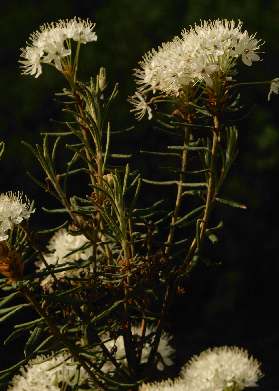
|
|
Flowering marsh tea
|
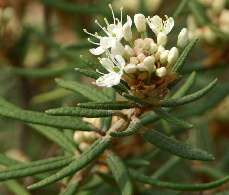
|
|
Wild rosemary, flowers
|
-
Wild rosemary (Marsh tea, Ledum palustre, Ericaceae/Ericales/Cornidae) is a wild plant of bogs and swamps of the Northern
hemisphere. There are several subspecies, one of which (Labrador tea
) is
a popular tea plant in Canada. The European form was, like the ecologically
similar gale, used for gruit beer,
although it contains narcotic sesquiterpene alcohols and is not fully
harmless.
-
Sorrel (Rumex acetosa, Polygonaceae) is known for its acidic
and pungent leaves which contain oxalic acid. It is used occasionally, e. g., in
Green Sauce.
-
Tansy (Tanacetum vulgare, Asteraceae) grows all over Europe, but as
far as I know, its culinary usage is restricted to Britain. The leaves have a
dominant, not very agreeable, odour which is mostly due to the toxic thujone
(see also southernwood).
-
Woodruff (Galium odoratum,
Rubiaceae/Gentianales/Cornidae)
grows wild in the forests of Western Europe. On wilting of the aerial parts,
coumarine is liberated (see also tonka bean)
which gives its incomparable flavour to some traditional flavoured wines.
The area around the Mediterranean Sea, belonging in part to Europe, Asia and
Africa, has always been a cultural unity. Early spice trading routes lead from
China and India via the Arab peninsular to the Mediterranean Sea, which made
the region an important place of cultural and culinary exchange. In the warm
Mediterranean climate, many fragrant plants grew abundantly; and in the
course of millennia, even more have been introduced by traders, refugees or
immigrants from further East.
The following are generally considered as native Mediterranean plants; however, some
are open to dispute, e. g., cumin or even the
apparently typical Mediterranean
olive.
Asian spices became popular in Europe first in the Age of Hellenism. Later,
spice trade blossomed in the late days of the Romans, about two thousand years
ago; from the beginning, spice trade was dominated by the Arabs.
Apicius’ De re coquinaria is one of the oldest European
cookbooks; it lists some tropical spices, of which long
pepper was most valued. Black
pepper, cloves and
Chinese cinnamon (cassia) also figure
prominently. The enigmatic spice silphion
(probably of Northern African origin)
became extinct around 100 AD and was substituted by
asafetida (from Central Asia).
The usage of olive oil is a cultural constant
in the Mediterranean since five millennia.
Today, Mediterranean Europe mostly relies on its native or imported herbs. Basil (stemming originally from South or even South East
Asia) today grows wild all over South Europe and is used extensively,
especially in Italian cuisine; the same holds for the indigenous
oregano. Garlic figures
more prominently than in Northern European countries. Regionally, saffron
is used for fish or sea food specialties, but the high price of this
spice limits its usage. Throughout the region, some dishes require small
amounts of chiles; fiery food, however, is not
typical.
Typical spice mixtures from Southern Europe are bouquet garni (see parsley) and Herbes de
Provence (see lavender).
In Asia Minor and West Asia, herbs cease to be dominant. Coriander and cumin (from
Persia, but grown locally) are popular, and the use of pungent spices (mainly
black pepper and chiles)
becomes more common. The berries of the sumac tree
are essential to reproduce the astringent and sour taste found in many dishes
from Turkey to Israel.
In Northern Africa,
chiles take an important part in
fiery stews and sauces. Coriander and cumin both are used extensively, but also African
spices (grains of paradise) are common. Of the spices
from tropical Asia, cinnamon and cloves find most use. All these, and more, may appear in
Moroccan spice mixtures (ras el hanout, see cubeb
pepper).
Although a large number of Mediterranean herbs is discussed here, the treatment
is not exhaustive: There are many more that find their way in the kitchen on
occasion. Sometimes, these are wild relatives of herbs treated here which are
collected by knowledgeable family members, because their flavour is regarded
superior to that of commercially grown ones. This usage is often very local
and is hardly mentioned in cookbooks. This applies particularly to herbs of
the mint family, e. g.,
thyme, marjoram and
especially oregano. Further interesting plants
from the Mediterranean are:
-
Black lovage (alexanders, Smyrnium olusatrum, Apiaceae) is similar to lovage and celery, having
aromatic roots, leaves and fruits. Today, the culinary importance of that
herb is low.
-
Mastic (mastiha [μάστιχα])
is a resin obtained from Pistacia lentiscus var. chia
(Anacardiaceae), a tree growing only on
the island of Chios in Eastern Greece, though lesser grades are harvested
from related species. It was an important commodity in the Middle Ages, but is
now only used in Greek cooking (see mahaleb cherry
for more).
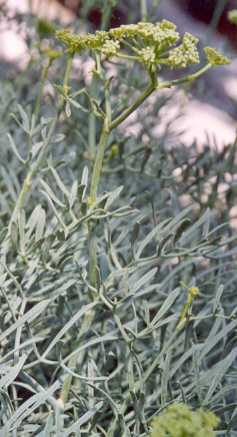
|
|
Samphire
|
-
Samphire (Crithmum maritimum, Apiaceae) grows along all coasts of
Europe, from the Atlantic Ocean to the Black Sea. The leaves are succulent with
a salty–aromatic flavour and have been a popular flavouring for salads in the
past; samphire pickle, formerly much eaten in Britain, is now still popular in
the Mediterranean.
-
Pennyroyal, Mentha pulegium (Lamiaceae), differs markedly from culinary
mints. It is used since antiquity in Roman cooking
(see silphion). Despite its mild toxicity, it is a
traditional herb in Britain.
-
Calamint, Calamintha nepeta, is an aromatic herb used
in regional Italian cooking (nepitella). Its flavour reminds
of related Lamiaceae herbs,
e.g., thyme, mint
savory or oregano.
-
Pine nuts (pignoli) are
the seeds collected from the Mediterranean stone pine (Pinus
pinea, Pinaceae/Pinales); in temperate Asia,
related pine species are also used. They have a
wonderful ethereal–aromatic flavour and are particularly important in
Spanish and Italian cooking, e. g., for pesto
(see basil).
-
Purslane (Portulaca oleracea,
Portulacaceae/Caryophyllales) is an annual
herb probably native to the Himalayas, but today naturalized in Western Asia
and Southern Europe. Although often eaten cooked as a vegetable, the raw
leaves and stems have a crispy texture and a salty, fresh taste that makes them
a good garnish for Mediterranean cold foods, e. g., West Asian appetizers. The
flower buds have a more pronounced flavour and have been tried as a
caper substitute.
Many important spices actually stem from West or Central Asia, even if some of them are
in our days cultivated from Morocco to Vietnam:
Possibly, cumin and some other of the
spices listed in the previous section have their origin actually in western
Central Asia, being spread westwards by migrating peoples in prehistoric times.
Today’s Persian or Arabian cooking uses a multitude of spices, having easy
access to Indian or Southeast Asian ingredients.
Cardamom is much valued as an essential component
of Arab-style coffee.
Cooking styles of the Arabic peninsular have a preference for aromatic but
fiery food. Yemeni zhoug (see coriander),
a spicy chili-laden paste, and Saudi Arabic
baharat (see paprika) may serve as examples.
The Caucasus republics, situated between the Black Sea and the Caspian Sea,
have developed a unique style of foods, although Russian and Turkish
influences can bee seen. Georgia has a mild yet flavourful cuisine much basing on the
flavours of dried herbs (see blue fenugreek for
the Georgian spice mix khmeli-suneli [ხმელი-სუნელი]) and of sour–fruity
sauces prepared from fresh or preserved fruits.
Fresh herbs are often sprinkled over warm and cold dishes; uniquely, Georgian cooking makes parallel use of both
parsley and coriander leaves; the latter are not used
anywhere else in the region.

| |
Barberry flowers
|
|
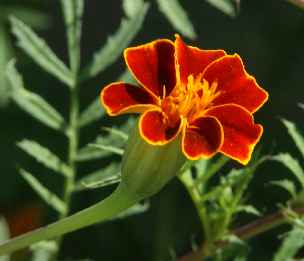
|
Imeretian saffron
|
|
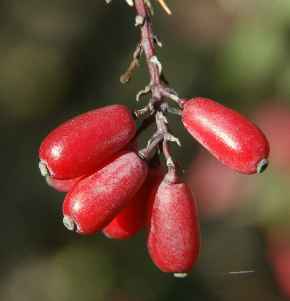
|
|
Barbery fruits
|
A similar inkling to
fruity flavours is found in neighbouring Azərbaycan (Azerbaijan) and in Iran.
A typical Irani spice that is, unfortunately, missing from these spice
pages is barberry, Berberis vulgaris (Berberidaceae/Ranunculales), called
zereshk or sereshk [زرشک] in Farsi
and k’ots’akhuri [კოწახური] in Georgian;
it is often used to flavour ground meats or Persian rice dishes
(polo [پلو]). Another source of sour flavour in Irani
foods are dried limes (see also
fenugreek for
khoreshte ghorme sabzi).
An interesting herb typical for Georgian cooking is marigold (Tagetes erecta, Asteraceae),
which appears in several recipes including the spice mix khmeli suneli (see blue fenugrek). In Georgian, it is simply called yellow flower
(q’vit’eli q’vavili [ყვითელი ყვავილი])
or Imeretian saffron
(imeruli zaprana [იმერული ზაფრანა]),
and sometimes just zaprana which can lead to confusion with the much different saffron.
The marigold flowers are dried and ground to yield a yellow powder that hat a mild, sweet scent. It can best be substituted by
safflower. Sometimes, also the fresh sprigs are used that have a different, much stronger
flavour reminscent of the South American huacatay.
The proper Central Asian region, between the Caspian Sea
and the Tianshan mountains [天山],
is a region
rather devoid of local spices, although imported spices are available since antiquity,
because the ancient Spice Route running from China to the Mediterranean cuts through that region.
Cookbooks of Kazakhstan sometimes mention local herbs with cress-like
flavour. Combinations of dried fruits with meats are very popular, where cooks often use local
species of genus Prunus (apricot, plum).
South Asia, which encompasses the Deccan peninsular and the southern slopes of
the Himalayas, has a variety of indigenous spice plants. Furthermore, Southeast
Asian spices have been traded in India since thousands of years. Therefore,
Indian cuisine is one of the most fragrant and aromatic in the world.
A large number of spices native to South Asia has been exported long
ago either to the West or to the East. For example, in today’s South East
Asia, we find spices of Indian origin that have no place in today’s Indian
cooking, e. g., lemon grass or
lesser galangale. The following table shows
only those South Asian spices that flavour the contemporary South Asian kitchen.
In today’s Indian cuisine, many more spices play an important part. Chiles, brought to Asia from the New World by the
Portuguese, are used generously, especially in South India and Sri Lanka. Tamarind (from East Africa) is used to give some
Southern Indian curry dishes a sour and tart flavour. Of the European and
Central Asian spices, coriander, cumin and garlic are now
indispensable for the taste of Indian food. Cinnamon, originally growing on the island of Sri Lanka,
is now valued all over India and frequently combined with cloves, which stem from Southeast Asia.
Arab influence in South Asia is strongest in Afghanistan, Pakistan and North
India. Cooks in these regions tend to use less chiles but more fragrant spices
(cloves,
saffron and
cinnamon).
There are numerous spice mixtures in India, but most of them have nothing in
common with the curry powder of Western supermarkets (see curry leaves). Most mixtures are actually not powders
but pastes, made from ground spices, garlic, ginger and oil and are neither stored nor traded.
Mixtures containing only dried spices are the Bengali
panch phoron [পাঁচ ফোড়ন] (see fenugreek),
the North Indian garam masala [गरम मसाला, گرم مسالحہ, also گرم مصالحہ]
and the more Southern sambar podi [சாம்பார் பொடி]
(for the latter two, see cumin and coriander, respectively).
Southern Indian mixture (bese bele powder) is mentioned under
coconut.
See black
cumin about Northern Indian (Moghul style) cooking, and
ajwain about spiced butter (tadka
or tarka). See also onion.
For a few typical recipes, see Indonesian bay-leaf for the aromatic Northern
biriyani and tamarind for
the fiery Southern vindaloo. Indian spiced tea
(chai masala [चाय मसाला]) is discussed under
cardamom.
Nepali cooking resembles Indian cooking in several ways, and some preparations,
e.g., pickles, are quite comparable. Nepali food is typically milder than
Indian food, both with respect to actual heat and usage of aromatic spices.
This doesn’t make the food of Nepal bland or uninteresting, because due to
Chinese influence, there are several additional flavourings made by
fermentation: Cheese, soy products and the typical Nepali
gundruk [गुन्द्रुक],
dried fermented vegetable leaves. Noodles in various
styles are another culinary mark left by neighbouring China.
Finally, Burma, or Myanmar, as it is now called, is the meeting place and
melting pot of the great cooking traditions of India and Southeast Asia.
Noodles, shrimp paste, soy sauce and sesame oil on
one side and cardamom, cinnamon, turmeric and cumin on the other side witness the mixed heritage and
give Burmese curries their distinct and very tasty character.
Fish flavourings are rare in the Indian subcontinent; this is in line with the observation that fermented products generally have only little tradition.
The main exception to that is dried fish in Sri Lanka (umbalakada [උම්බලකඩ]),
which is usually referred to as Maldive fish
in English. Yet, fermented preparation from water-living organisms play an imortant rôle in North Eastern India and
the Chittagong Hill Tracts in Eastern Bangladesh, which indicates South East Asian influence (mostly, Burmese). The Khasi people use a paste of fermented fish with
various spices (tungtap) as a condiment, the Chakma employ shrimp paste (sidol [𑄥𑄨𑄘𑄮𑄣𑄴])
for cooking, and in Manipur, the Meitei have a dry-fermented fish called ngari [ঙারি, ꯉꯥꯔꯤ].
More rarely, fermented soy bean products are found in that region: Khasi tungrymbai, Manipuri hawaijar [হাৰায়জার, ꯍꯥꯋꯢꯖꯥꯔ].
I am fascinated by Indian cooking; consequently, my treatment of Indian spices
is intended quite exhaustive. Nevertheless, there are some Indian spices of
which I still know too little to write a detailed description:

|
|
Dried kokam
|
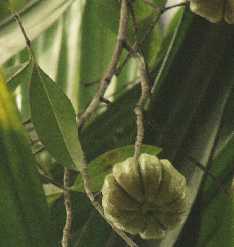
|
|
Goraka fruits grow on high trees
|
-
First of all, one should mention kokam ([कोकम], kokum,
Garcinia indica,
Clusiaceae/Theales/Dilleniidae),
a souring agent for South West Indian fish curries. The main constituent responsible for the acidic taste is hydroxycitric acid.
-
In Sri Lanka, goraka [ගොරකා, கொறக்கா] is a
similar spice also rich in hydroxycitric acid, derived from Garcinia cambogia. It is used for many meat and particularly fish curries,
imparting both a refreshing sour note and a brownisch colour to the foods.
-
There is a little-known spice radhuni [রাধুনি]
or randhuni [রাঁধুনি] used only in Bengali cooking
and practically unavailable outside of Bengal. Its botanical identity is
Trachyspermum roxburghianum (Apiaceae, Hindi: ajmud),
but it gets often confused with ajwain. True
radhuni has an aroma comparable to celery and fenugreek.
Truly authentic variants of the Bengali spice blend panch phoron
contain radhuni where the common mixtures have
black mustard seeds
(see nigella for details).
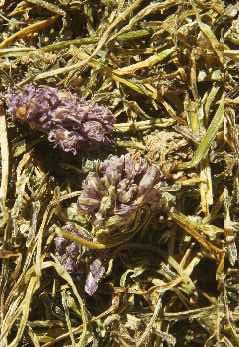
|
|
Dried jimbu (seen in Mustang, Nepal) with remants of flowers
|
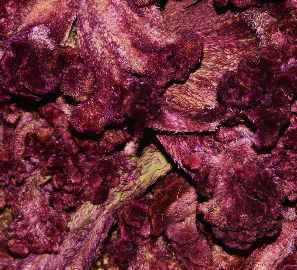
|
|
Dried cockscomb (found on a market in Kashmir)
|
-
In Nepal, jimbu [जिम्बु] are the dried
leaves of a local onion species (Allium wallachii (variously also identified as A. hypsistum or A. przewalskianum,
Alliaceae). The plants grows in the higher part of the Himalayas (Mustang district) and is collected from
wild populations. It is a local spice mostly used by ethnic groups living in that area (especially Thakali, also Gurung). When fried very shortly,
is relases a flavour very similar to asafetida which is not known in that region. In the Indian union state Uttakhand,
the spice is known as jambu [जम्बू] and used equivalently.
See chives for some more usage notes.
-
Cockscomb (Celosia argentea var. cristata,
Amaranthaceae/Caryophyllales)
is a common ornamental in some European countries. In India, the bright red
flowers (Hindi lal murghka,
Kashmiri moul [مول]) are used as a food colourant.
-
Horseradish tree (Drumstick tree, Moringa oleifera, Moringaceae/Capparales)
grows wild in Northern India (Southern foothills of the Himalayas). The tree
is very versatile: The young fruits (drumsticks) are eaten as a
vegetable, an interesting oil (ben oil) is extracted from the seeds,
the leaves are used medicinally and the root and root bark are rich in
glucosinolates, which lend them a pungent, horseradish-like flavour. Nevertheless, this is
one of the more rare flavourings in Indian cooking.
-
The wild tree Buchanania lanzan (Anacardiaceae) yields edible seeds
(chironji [छीरोंजी])
with almond flavour;
they are used in India, particularly the North East, to make sweets.
-
The herb Saussurea lappa (syn. S. costus)
(Asteraceae)
is native to Kashmir and grows nowhere else; in India, it is known as
putchuk or
kushtha [कुष्ठ],
and in the West, the name costus is most
common. The dried root has a strong, perfumed odor and is often used in
perfumery; in late antiquity and the early Middle Ages, it was used
in Europe as a culinary spice.
-
Spikenard (Nardostachys jatamansi,
Valerianaceae/Dipsacales/Cornidae,
Sanskrit jatamansi [जटामांसि]
or jatavati [जटावती])
is a similar case: It is also native to the Himalaya region and is of great
importance for perfumery, but in our times practically never used for cooking.
The related herb Valeriana celtica (Alpine valerian, speick)
was, since the Middle Ages, often used as a cheaper substitute for expensive
spikenard.
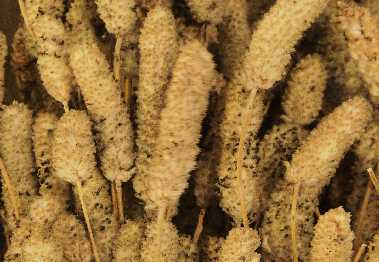
|
|
Dried niepfü
|
-
Indian cuisines, generally, use very little herbs besides coriander and to a lesser extent mint.
Yet, the cooking styles on the North-Eastern edge are an exception to that and employ a large number of herbs also found in Southeast Asia, most so
in the Manipur state. There, cooks make use of chameleon leaf, dill, long coriander
and even Vietnamese coriander.
-
A herb unique
to that region is Elsholtzia blanda, known as lomba [লোম্বা, ꯂꯣꯝꯕꯥ]
in Manipuri, lengser or lengmaser in Mizo, niepfü or rünou in Angami Naga, zutsu in Lotha Naga and napa in Ao Naga.
The dried inflorescence, which form a thick spike, has an intensive fresh lemon fragrance quite similar to
lemon verbena and is used to flavour pickled bamboo sprouts and soupy fish curries.
-
A closely related herb is Elsholtzia fruticosa sometimes called Shrubby Mint in English,, which I found not in Nagaland but only in Manipur.
It is locally known as kang-human [কাংহুমান, ꯀꯥꯡꯍꯨꯃꯥꯟ].
The flavour is quite comparable to Vietnamese balm which is closeley retated botanically and also looks very similar.

|
|
Dried alkanet (found on a market in Rajasthan)
|
-
Alkanet (Alkanna tinctoria, Boraginaceae) is a Mediterranean plant cultivated in India for its red
rhizome, which yields a dye (Hindi ratan jot [रतन जोत]).
The dried rhizome is occasionally used as a food colouring in the North West.
-
The so-galled mango ginger (Curcuma amada) is a minor and rather strictly South Indian spice.
The plant much resembles turmeric, but the rhizome is only pale yellow; its scent indeed mimicks the fragrance of unripe mangos very closely.
-
A rather enigmatic spice
of Southern India is a dried lichen referred to as kalpasi [கல்பாசி] in Tamil
and dagor phul in Marathi (the latter name occasionally stands for star anise, though).
The plant material is rather tastelesse, but it is widely used; I am not sure about its culinary merit.
Due to its tropical climate, Southeast Asia has a large number of native
aromatic plants, most of which are preferred fresh in local cuisines. The
Moluccas, a group of small islands on the border between Asia and Australia and
home of nutmeg and cloves, have been the center of European spice policy in the
late Middle Ages and the first centuries of the modern times.
Today, all these spices (with the exception of
cinnamon varieties, cloves
and nutmeg, which are not so much in use) feature
prominently in at least some of the major
South East Asian cuisines. Furthermore, chiles,
ginger and garlic are found
all over the region, as are coconut products:
coconut milk and coconut oil.
In Southeast Asia, numerous independent culinary styles have evolved; yet most
of them prefer spices fresh (if available), and also fresh herbs
(basil, coriander leaves
and mint) are popular as a fragrant decoration in
Vietnam, Cambodia and Thailand. Throughout the region, pungent fish preparations
are essential: Fish sauces
(nam pla [น้ำปลา] in Thailand,
nuoc mam [nước mắm] in Vietnam), shrimp pastes
(gapi [ငပိ] in Burma,
trassi in Malaysia and Indonesia) and the unique Cambodian
paste prepared from fresh water fish, prahok [ប្រហុក]. Fish sauce
is also known in Southern China, where it is called yu lu [魚露];
but in Chinese cuisine, it is only a minor flavouring.
Thai cooks use even more spices
(e. g., kaffir lime leaves, lemon
grass and fingerroot) and other strong-smelling
ingredients like dried fish to achieve the characteristic aroma of Thai dishes.
Since they use chiles generously, Thai food is
sometimes extremely hot and fiery. For Thai curries, see
coconut. See also basil
and mint for more Thai recipes.
In Cambodia and Vietnam, spice usage is not that dominant, and also
Philippinos cook rather mildly. Besides garlic and
ginger, Philippine cuisine makes use of the
South American annatto seeds. This spice was
introduced to the Philippines by the Spaniards and is hardly known in other
Asian countries.
Vietnamese cuisine is unique for its massive use of fresh herbs, some
of which are used only rarely outside of Vietnam
(Vietnamese coriander, long
coriander), while others (rice paddy herb,
chameleon herb) do not appear in other any other
cooking style at all.
On the numerous islands of Indonesia, lots of very different regional cuisines
have developed, which is to be explained by different life conditions (jungle
nomads, farmers or seafarers; village-bound or cosmopolitan urban cultures),
food taboos because of different religions (Islâm, Christianity,
Hinduism, Buddhism, Animism), different climates (tropical jungle, mountain
woods, highlands or even dry areas) and several other factors.
Most Indonesian cuisines do not use sweet spices, which is all the more
remarkable because cloves,
nutmeg and the Sumatra
cinnamon variety are indigenous to Indonesia.
Instead of these, the most popular spices are
ginger, onion,
garlic and moderate amounts of
chiles, furthermore
galanga and
turmeric.
Indonesian dishes frequently need shrimp paste (trassi) and
soy sauce (kecap), which is also used in a thick and very sweet
variety (kecap manis). Especially Jawanese dishes sometimes
contain large amounts of sugar and taste sweet–spicy, while I enjoyed
rather hot food in Sumatra, and Bali certainly displays the largest
variety of different spices.
Some highlights of Indonesian cookery are shortly discussed under
greater galangale (rendang,
a buffalo stew from Western Sumatra), Sichuan
pepper (sangsang, a spicy pork variety meats stew
from Northern Sumatra), coconut
(ayam pa’piong, a chicken dish from Sulawesi),
mango (the pan-Indonesian fruit salad
rujak) and lesser galangale
(bebek batulu, Balinese roast duck). About Indonesian
spice pastes (bumbu) in general, see lemon grass, for information about Balinese
cuisine see Indonesian bay leaf and for
Jawa cookery see tamarind.
Many more herbs and spices are used in the many and varied culinary styles of
that large region. Particularly in Vietnam, there is a large whealth of local
herbs that are not commonly available in the West. The following are particularly worth noting:
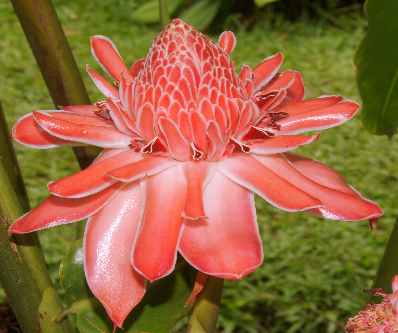
|
|
Torch ginger
|
-
Torch ginger (Etlingera elatior, Zingiberaceae) is a unique spice: The
inflorescence is used to flavour curries in Singapore and Malaysia
(bunga kantan).
-
In Thailand (cha pluu [ช้าพลู])
and Vietnam (la lot [lá lốt]),
fragrant wild betel leaves are commonly used to wrap rice or other
foods into. These leaves stem from a member of the pepper genus
(Piper sarmentosum, Piperaceae)
which is closely related to the so-called betel pepper, Piper betle,
in indispensable part of the betel bits consumed in South East Asia and
India (pan [पान]).
-
Musk mallow (ambrette, Abelmoschus moschatus, Malvaceae/Malvales/Dilleniidae)
is a closely related plant with aromatic seeds. There is constant
rumour of it being used as a coffee flavourant, but I don’t even know where
this usage is supposed to happen.
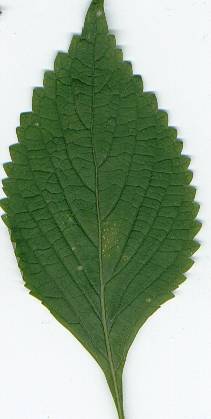
|
|
Vietnamese balm
|
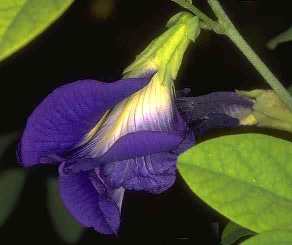
|
|
Butterfly pea
|
-
Vietnamese balm (Elsholtzia ciliata, Lamiaceae) plays some rôle in
Southern Vietnam (rau kinh gioi [rau kinh giới]) as part of the canonical herb
garnish (see Vietnamese coriander).
-
Butterfly pea (Clitoria ternatea, Fabaceae) has
large, deeply blue flowers that are used to give a bluish hue to desserts
in Thailand
(anchan, anjan [อัญชัน]) and Malaysia
(bunga telang). In our days, it is mostly substituted by
synthetic food colourants.
-
Broadleaf thyme (Cuban oregano, Indian borage, Mexican mint,
Plectranthus amboinicus, Coleus amboinicus,
Lamiaceae) is a herb native
to South East Asia, though it has been introduced to the Caribbean. The
leaves posses a strong odour due to an essential oil rich in carvacrol.
The fresh herb is used in Indonesia (daun jinten), but
especially in Vietnam (rau day tan las [rau tần dầy lás]), as a garnish.
-
Quite rarely, I have read reports claiming that the pungent seeds of some
members of the Araceae family (e. g., Giant Elephant’s
Ear, Colocasia gigantea) are used as pepper surrogate in
South East Asia.
-
The fruits of the tree Garcinia atroviridis (Clusiaceae/Theales/Dilleniidae)
are used as a source of acidity especially in
Malaysia (asam gelugur), similar to the use of other Garcinia species in South India and Sri Lanka.
-
Aleurites moluccana
(Euphorbiaceae/Euphorbiales/Dilleniidae)
yields seeds (candle nut
, kemiri) which are a
very common although bland ingredient of Indonesian spice pastes. See
also lemon grass about spice mixtures containing candlenuts.
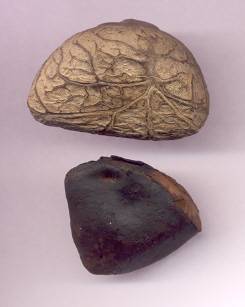
|
|
Pangi seeds (shelled and unshelled)
|
-
A quite interesting spice is derived from the Indonesian
pangi or kepayang
tree, Pangium edule
(Flacourtiaceae/Violales).
The seeds, known
as kluak or kluwak in Indonesian and
as pamarassan in bahasa toraja,
are an ingredient typical for a few Indonesian local cuisines, e. g. in East
Jawa and Central Sulawesi. They provide a dark colour, an intensive nutty
taste and a smooth, somewhat oily texture. For flavour development and removal
of hydrocyanic acid, the seeds need a fermentation procedure by which they turn
from cream colour to almost black.
-
Sandalwood (Santalum album, Santalaceae/Santalales/Rosidae)
is the core wood of a parasitic plant native to the Lesser Sunda
Islands, probably Timor. Today much of it is grown in Southern
India and used for incenses. Though powerfully fragrant, it has
never been used much for cooking.
The whole East Asian region is dominated by Chinese culture. Chinese cookery is
very varied and highly sophisticated; it has influenced all East Asian cuisines,
and is also a important contribution to all South East Asian culinary styles.
Chinese cuisine derives its attraction not so much from different spices, but
from a multitude of meat and vegetable ingredients with different flavour,
shape, colour and texture, and from a wealth of standardized cooking and
frying methods; the only common spice mixture is the famous
five spice powder (wu xiang fen [五香粉],
see star anise), which is frequently
used to flavour fried meat all over China.
Soy sauce (jiang you [酱油])
is the most important condiment in China, but to prepare authentic Chinese
foods, also other soy products are needed, for example
sweet bean paste (haixian jiang [海鲜酱],
better known by its Cantonese name hoisin jeung [海鮮醬]),
hot bean paste (douban jiang [豆瓣酱])
and fermented black beans (dou chi [豆豉]).
The least spicy cooking style in China is Cantonese cuisine, which is native to
the Guangdong province [广东, 廣東].
The name Cantonese
derives from the province capital Guangzhou [广州, 廣州]
that was formerly known as Canton
in the West. Cantonese cuisine has a reputation
for its exotic meat dishes made from dogs, cats, monkeys and snakes. It is also known for
a varity of barbecued meats (siu mei [燒味], Mandarin shao wei [烧味]),
for example spare ribs (cha siu [叉燒], often spelled
char siu in the West,
Mandarin cha shao [叉烧]).
A famous Cantonese food term is dim sam [點心]
(in English also spelt dim sum), which is not a dish but a light meal
composed a selection of small dishes; a most popular choice are meat-stuffed dumplings
made from ground pork, chicken or shrimps with light yet subtle flavourings. Outside of
Guangdong, the term has mainly come to mean a variety of such steamed pasta.
Though Cantonese in origin, dim sam is now enjoyed all over China
(Mandarin dian xin [点心]).
-
By tradition, fiery food is rather uncommon in China, except in two Central Chinese
provinces: Hunan [湖南, 湘] and
Sichuan (Szechwan) [四川, 川],
which is also known as Tian-fu [天府] (heavenly province
or land of plenty
).
In these both provinces, but especially in Sichuan, chiles, garlic and
aromatic sesame oil are popular.
An important flavouring of Central Chinese cookery is red hot bean paste,
doubanjiang [豆瓣酱] made from fermented broad beans.
Due to domestic migration, spicy Sichuan and Hunan foods have recently
become available and popular in wider parts of China. In contrast, the cuisine
of the mountainous Yunnan province [云南, 雲南]
has not yet attracted much interest, though it is spicy and related to the Sichuan cuisine.
-
The North-Eastern Chinese cooking is usually termed the Shanghai [上海] style.
It is particularly rich and often uses sweet flavours. A typical motive of Shanghai cooking is the
use of rice wine (liao jiu [料酒]).
Red-braising (hongshao [红烧])
is a cooking technique that originates in Shanghai, although it is today commonly found all over China.
-
The fourth and last Great Cuisine is the Northern Beijing [北京] style,
which has a large repertoire of baked foods (a Central Asian influence) and uses more wheat than rice due to
climatical reasons. Two signature dishes are Beijing duck (beijing kao ya [北京烤鸭])
and Mongolian hotpot (meng-gu huo-guo [蒙古火锅]).
Furthermore, sweet and sour dishes are popular: Fish ore meat are battered, deep-fried and served with a sweet–sour sauce
(tangcu [糖醋] sugar and vinegar
)
A handful of Chinese dishes are shortly discussed at this site:
See ginger on gong bao [宫保] (stir-fried chicken with peanuts in Sichuan style),
orange on au larm (Sichuan braised beef),
Sichuan pepper on shui zhu niu rou [水煮牛肉] (Sichuan water-boiled beef)
and chile on mapo doufu [麻婆豆腐] (bean cheese with ground pork in spicy sauce).
See also star anise about
five-spice-powder (wu xiang fen [五香粉])
and cassia on red braising (hongshao [红烧])
and cooking in master sauce (lu shui [鹵水]).
Cuisine in Japan restricts itself to utmost simplicity with respect to spices:
Only Sichuan pepper (more precisely, a closely
related Japanese species) is used as a condiment, either alone or mixed with
tangerine or orange peel and chiles in form of the spice mixture
shichimi tōgarashi [七味 唐辛子].
Japanese dishes, thus, owe most of their flavour to their
ingredients, whose freshness and skilful preparation are crucial, furthermore
to dried sea grass and kelp, several different soy products (e. g., soy sauce
shōyu [醤油, しょうゆ])
and other fermented
crops (miso [味噌, みそ]).
A pungent root, wasabi, is
served as a green paste to raw fish (sashimi [刺身, さしみ])
and rice bits (sushi [ 寿司, すし]); several herbs
(water pepper, perilla
and the young leaves of Sichuan pepper) are used
both for flavour and as a decoration.
In sharp contrast, the cuisine in Korea, the most Eastern country of East Asia,
is fiery and pungent, dominated by chiles, toasted
sesame seeds and garlic; pickled vegetables (kim chi [김치]),
both spicy and sour, are also very popular. Soy bean paste (den
jang [된장], also spelled doen jang or
doin jang) similar to Japanese miso
and bean-chile paste (gochu jang [고추장], also spelled
kochu jang) are essential flavourings. In both Korea and Japan,
fresh spring onions are a common garnish.
There are some further local herbs and spices that are occasionally used.
For example, Chinese cuisine utilizes several local onion
species (Allium, see chives); for
Sichuan, particularly, cookbooks mention local Himalaya herbs
but don’t
give any clear identification. We should also note the following:
-
Ginseng (Panax ginseng, Araliaceae/Araliales)
is mainly known as an expensive herb in traditional Chinese medicine,
and as a flavouring for alcoholic drinks. Nevertheless, it is also used as a
culinary spice, especially in Korea.
-
Camphor is of old an important aromatic, although it has never much
been used for cooking. Yet in China, camphor has been used in the past
for flavouring frozen desserts, and even now it is sometimes part of
smoking mixtures, giving rise to specialties like
tea and camphor wood smoked duck (zhang cha ya zi [樟茶鸭子]).
There are two different products commonly named camphor
:
The better-known Chinese or Japanese camphor (from
Cinnamomum camphora, Lauraceae)
is composed of 2-bornanone
and generally considered much inferior to the much more pricey Sumatra
camphor or camphor of Baros (from Dryobalanops aromatica,
Dipterocarpaceae/Malvales/Dilleniidae)
which is mostly composed of borneol.
-
Japanese cuisine uses the fresh leaves of
mitsuba [ミツバ, みつば]
(Cryptotaenia japonica, Apiaceae),
as a culinary herb. Fresh leaves are chopped and sprinkled over soups or salads.
In Chinese, the herb is known as ya er qin [鸭儿芹]).
Few African spices have ever become known in the West. Personally, I know only
four, of which sesame’s origin is uncertain.
During the Age of Explorations, the former two (from West Asia) were traded as
cheep substitute of black pepper, unless the sea
route to India was established. Later, people lost interest in them and they
are now nearly forgotten (and difficult to obtain). Silphion is the name of a legendary spice in ancient
Rome, which was so popular that it became extinct in the early Imperial era.
Its botanic classification is subject to debate.
Tamarind probably
stems from East Africa, but is in our days grown in tropical climate all
over the world and is an important ingredient in Asian or Latin American
cuisine.
Sesame is one of the most important oil seeds of
mankind, yet little of the crop is used as a spice. Specialties containing sesame
are found all over the Old World, from Europe to Korea.
Today’s African cooking is dominated by Arabic influences, mostly so in the
North and East, where Islâm prevails. In the South, there is much
colonial influence, both by European colonists and immigrants from India and
Malaysia. East Africa has absorbed Arabic and Indian cooking techniques
and developed a unique cuisine by blending foreign influences with local
traditions. Cooking in West and Central Africa has conserved
its distinct character and is hardly comparable to any other culinary style.
In West Africa, e. g. in Nigeria, Cameroon, Ghana, Benin, food is often very
pungent due to the use of extrahot chiles
that have been imported from the Caribbean. Other important flavourings are
dried fish products, smoked meats and toasted peanuts; the typical cooking
medium is unrefined palm oil (from Elaeis guineensis) whose
flavour also contributes significantly to the character of West African cooking.
Furthermore, a number of local spices are used that are, however, hardly
available outside the region (except grains of
paradise and, if one is very lucky, negro
pepper).
In North Africa, however,
subtle spice mixtures based on cumin and
coriander dominate, and aromatic Asian spices
are popular. See cubeb pepper about the exceedingly
complex mixture ras el hanout. Arabic or Indian influence is
manifest in spice mixtures like Tunisian gâlat dagga
(see grains of paradise) and Ethiopian
berbere (see long pepper).
Quite many spices of other continents are grown in today’s tropical Africa,
where they are mostly planted as cash crops
and exported. Nigeria, for
instance, is a large producer of ginger. The
tiny but
fertile islands East of Africa are sources for several of the finest spices for
European consumers: Réunion (formerly known as Bourbon
) exports vanilla and allspice, and
Zanzibar has long outgrown Indonesia as the major clove producing country.
I don’t know much about other native African spices, which of course does not
mean that those do not exist. For example, various scented pelargoniums
are native to South Africa; they are often referred to as
scented geraniums
but belong not to genus Geranium but
Pelargonium, which is closely related but distinct
(Geraniaceae/Geraniales). These herbs have
an amazing spectrum of different flavours, most often
lemony or rose-like
floral, but there are also types with fragrance resembling
mint, cinnamon
and even nutmeg. Nevertheless, these
astonishing plants have not yet found much application in cooking,
although a few varieties are grown for the perfume industry.
Also in West Africa, the potentials of indigenous spices have not yet been
exploited. Most of the native West African spices are unavailable
in the rest of the world. In some cases, like the akob bark
and felom fruits (seeds?), I don’t even know the botanical
identity. Some more West African spices are mentioned in the below list.
-
Several species of genus Aframomum (Zingiberaceae) yield edible fruits and
pungent seeds, e. g., Aframomum danielli and
Aframomum citratum (mbongo spice
)
See also grains of paradise
-
The related genus Amomum also has representatives
growing in the tropic belt from Senegal to Ethiopia which are used locally. Some
of these have been traded as cardamom adulterants
or surrogates in the past. See also black cardamom.
-
Furthermore, there are African
pepper species like Piper clusii (see cubeb pepper).
-
Another source of pungent flavour might
be found in the numerous indigenous Zanthoxylum species
(Rutaceae)
found in tropical Africa, but the literature is scarce (see
Sichuan pepper about Asian relatives).
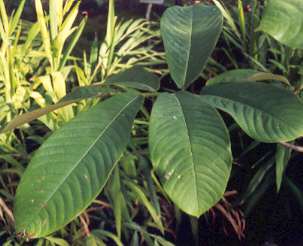
|
|
Calabash nutmeg leaf
|
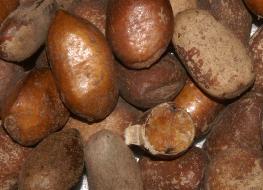
|
|
Calabash nutmegs
|
-
Calabash nutmeg
is the seed of Monodora
myristica (Annonaceae)
which was a common surrogate for nutmeg in 16.th
century Europe; today, the species is also grown on Jamaica. However, I do not
know about usage of calabash nutmegs in contemporary African or Caribbean cuisines.
-
The oily seeds of the tree Ricinodendron heudelotii
(Euphorbiaceae/Euphorbiales/Dilleniidae) have a
characteristic, strong flavour and are used as a spice and thickener for
sauces (local names njangsa, njasang).
-
Wild mango or bush mango is the fruit of the jungle tree
Irvingia gabonensis and the related species I.
wonbolu
(Irvingiaceae/Sapindales/Rosidae);
there is only a loose botanical relationship to mango. The seeds, dried and ground, are known as
ogbono and lend a sticky texture and presumably some flavour to West
African chicken stews (sauces
).
-
Koseret [ኮሰርት] is the Amharic name
of the herb Lippia adoensis (Verbenaceae) which is used as a culinary
spice in Ethiopia. It figures prominently in kitfo [ክትፎ], raw ground
beef flavoured with spiced butter. Most Ethiopian cookbooks silently replace it
by basil. See also
long pepper about the spice mixture
berbere.
-
Roselle (red sorrel, Hibiscus sabdariffa, Malvaceae/Malvales/Dilleniidae,
Arabic karkadi [كركديه])
is the purple, dried calyx of a plant related to
the popular ornamental hibiscus species. A refreshing acidic beverage prepared
from the calyces is quite popular in parts of Northern and Western Africa;
more rarely, one reads about roselle calyces being used in salty food, e. g.,
Indian and Malaysian curries.
The contribution of the two Americas to the list of spices is, unfortunately,
rather short. This is not for lack of aromatic plants, but mostly for lack
of information regarding native American spices in Europe. In the USA, due to
immigration, Latin American spices are easier to get by, but few of them
have found a permanent place in the spice shelf. Of course, there is this one
American nightshade plant that revolutionized almost any cuisine in the world …
Because in Northern America (the US and Canada) the cooking style is
largely derived from and not very different from European cuisine,
spice usage is generally rather low (exclude the Mexican-influenced
cuisine of the Southern states of the US from this statement). Currently,
there is only one plant native to North America treated on these pages:
Sassafras (filè) has great
though only regional importance in New Orleans cooking.
Allspice was introduced to Europe from the Caribbean
islands; its alternative name newspice indicates its origin from the New
World. Vanilla is native to México and has been used
for flavouring a chocolate-like drink since Aztec times. A culinary herb native
to México is epazote. Toasted
pumpkin seeds are an ancient flavouring of
Central American peoples that goes back to pre-Columbian times; yet extraction
of oil from toasted pumpkin seeds, as practiced in Central Europe, is a much
more recent invention.
From South America stem annatto seeds, much used
locally, and pink pepper, a spice that became
popular during the past decades in the nouvelle cuisine.
Further South American spices are tonka beans and
paracress, which have, however, found
only limited use outside of South America. Lemon
verbena is another spice generally underrated.
The most important spice of both Americas are, however, chiles and bell peppers,
which are both thought to be native to the Amazon region, but have been
traded extensively as far north as the southern states of today’s USA before
the arrival of the Europeans. Today, they are high valued in all tropical
countries of America, Asia and Africa.
Some more interesting plants from North, Central and South America are,
unfortunately, not yet treated on this page. Some of these are:
-
The Californian bay leaf tree (Umbellularia californica,
Lauraceae) possesses highly
aromatic leaves that have,
however, been mostly replaced by Mediterranean bay
leaves even in the USA in recent years.
-
The spice bush (Lindera bezoin, Lauraceae) is native to the Eastern USA.
All parts of the plant have a strong and pleasant, spicy aroma. The fruits
have been used as a substitute of allspice.
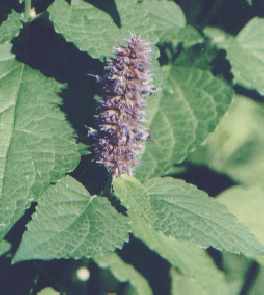
| |
Flowering anise hyssop
|
|
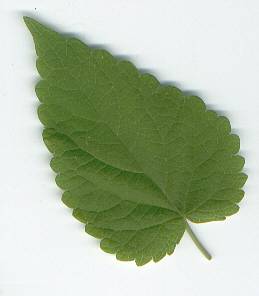
| |
Anise hyssop leaf
|
|
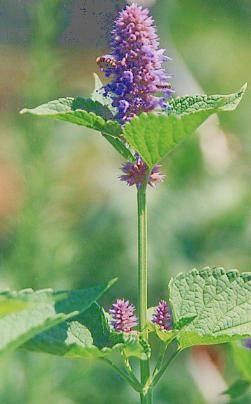
|
|
Anise hyssop inflorescence
|
-
Anise hyssop (Agastache foeniculum,
Lamiaceae) is native to
Northern America; though belonging to the same family, it is not particularly
closely related to hyssop. The broad leaves are
intensively scented, reminding of anise or
licorice, but are hardly ever used for cookery.
-
The early North American settlers knew about the aromatic leaves of
wintergreen (Gaultheria procumbens, Ericaceae/Ericales/Cornidae),
a dwarf shrub of Northern North America: wintergreen tea was a popular
beverage. Its aroma is due to an essential oil composed almost entirely of
methyl salicylate. The essential oil is still used to flavour candies and
confectionery in the USA and Canada.
-
Bergamot (bee balm, Monarda didyma and relatives,
Lamiaceae), was, similar
to the former, a popular tea herb in the days of the pioneers, which reduced
the dependency on expensive, imported black tea from Asia (Boston Tea
Party). It has a lemony, but as the same time
thyme-like, spicy flavour well suited for cooking.
See also lemon balm.
-
A sour beverage was brewed from the fruits of several American sumac
species, e. g., smooth sumac, Rhus glabra
(Anacardiaceae), but I do
not know about culinary usage comparable to
that of Mediterranean sumac.
-
West Indian bay leaves (also bay rum or Caribbean
bay-leaves) stem from the tree Pimenta racemosa
(Myrtaceae) or, according to
some other sources, also from the closely related
allspice tree. They have a strong
clove aroma and are particularly
used in the cooking of Jamaica and Cuba.
-
Mexican bay-leaves are quite different, stemming from Litsea
glaucescens (Lauraceae),
a tree closely related to the Mediterranean laurel.

|
|
Flowerings branch of White Cinnamon
|
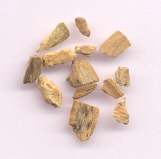
|
|
White cinnamon spice
|
-
The so-called White cinnamon (wild cinnamon,
Canella winterana, Canellaceae/Magnoliales) is native to
the Caribbean and Florida. Its aromatic bark is occasionally used as an
alternative for true cinnamon, yet I find
its aromatic-pungent flavour more akin to sweet flag or
galanga.
-
In Central America, there is much usage of herbs termed oregano
or marjoram
in
the cookbooks, but I suspect that local herbs are meant in the first place. At
least two different
herbs are known as Mexican oregano
: Poliomintha
longiflora (Lamiaceae)
and Lippia graveolens (Verbenaceae). Furthermore, there are
many more aromatic species in genera Lippia,
Coleus and Plectranthus (both
Lamiaceae) that have found
culinary applications locally.
-
Aztec herb (Lippia dulcis) is a shrub with leaves both aromatic
and intensely sweet. Despite its toxicity (due to Campher), it is moderately popular
among Western herb lovers (mainly for infusions), while I know nothing about indigenous use.
-
The herb Crotalaria longirostrata (Fabaceae) is indigenous to México
and used in Oaxacan cuisine, where its fresh leaves impart a mild bean
flavour to soups and tamales. It is referred to by
native names like chepil, chipil
and chipilín.
-
The name hierba de conejo (rabbit herb
)
refers to h herb used to flavour bean dishes in Tabasco and Veracruz.
Different sources give the botanical identity as
Tridax coronpifolia (Asteraceae)
and Castilleja lanata (Scrophulariaceae)
-
The heart-shaped leaves of Peperomia pseudoalpina
(Piperaceae) are a native
flavouring of some Central Mexican provinces (Oaxaca, Veracruz, Puebla).
The plant is known as tequelite or
cilantro silvestre coriander of the forests
, where
the latter name refers to both the coriander-like
flavour and the wild occurrence.
-
Yet another Mexican herb with coriander flavour is Porophyllum
tagetoides (Asteraceae)
with the local names pepicha,
pipitza, tepicha and
chepiche.
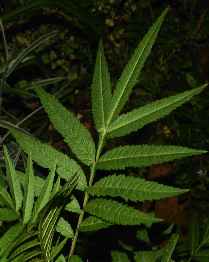
|
|
Huacatay
|
-
Peruvian coriander (Porophyllum ruderale, Asteraceae) is called papalo or papaloquelite in México and
killi or quillquiña in
Perú and Bolivia. Its flavour is reported intermediate between coriander leaves and
rocket
, but I don’t find it too similar to
those. This herb is employed like coriander leaves, mainly for salsa (Bolivia: sarsa).
-
Mint marigold (Tagetes minuta and
Tagetes elliptica, Asteraceae)
is an important herb in the Andean cuisines of Bolivia and
Perú. In cookbooks, it is mostly named by its name in Quechua
huacatay (Aymara wacataya).
The herb has a remarkable, spicy-fresh flavour and should be used only in
the fresh state, although a pesto-like concoction
(Salsa de Huacatay, black mint sauce)
can be made from it that preserves much of the original taste.
-
The peanut (groundnut, Arachis hypogaea, Fabaceae) stems from Southern America, but
is widely cultivated as a source of protein and oil all over the world.
Toasted peanuts are an important flavouring in many cuisines of West Africa and
South East Asia.

|
|
Heliotrope flowers
|
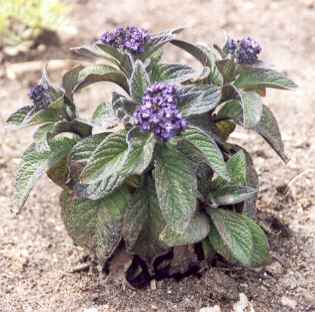
|
|
Fragrant heliotrope
|
-
Heliotrope (Heliotropium arborescens, Boraginaceae) is a common ornamental of
Peruvian origin; its
vanilla-scented flowers have, in Europe, been used
as a flavouring for pastry, fudge-like desserts and sherbets.
-
Sweet honey leaf (Stevia rebaudiana,
Asteraceae) is native
to the highland of Paraguay; it is traditionally used by indigenous peoples
as a sweetener, particularly for the local mate tea.
Fresh and dried leaves have an intensive sweet flavour due to several
diterpene glycosides (steviol, stevioside). Today, the plant is grown
on a commercial scale in Japan, where stevia extract plays an important
rôle as an artificial sweetener. In other countries, however, it has
not yet been so successful.

|
Native cinnamon bark (from Bolivia)
|
-
The members of genus Ocotea are trees with aromatic
leaves, bark and fruit calyces; in the two species O.
pretiosa and O. quixos native to the Amazonian basin,
the aroma comes close to cinnamon. In the 16.th
century, a large Spanish expedition perished, almost down to the last man,
while searching for the origin of this spice (see
annatto). Yet after its discovery,
American cinnamon
has not gained any culinary importance; but the
closely related species O. sassafras is commercially grown
as a source of safrole in Brazil.
Few plants of Australia have ever gained economical importance, macadamia nuts
(Macadamia integrifolia and M. tetraphylla,
Proteaceae/Proteales/Rosidae)
being the chief example. There are, however, plenty of aromatic plants, some of
which might gain some importance in the cuisines to come.
Both spices are currently hardly known (less used) outside Australia,
but in our global world, these things may change quickly. Note that
in Australia, there are more indigenous flavourings that can be considered
spices: The dried tiny berries of bush tomato (Solanum
centrale, Solanaceae)
have a complex taste not altogether dissimilar to Italian sun-dried
tomatoes, although less fruity and more spicy. Another candidate is
the so-called wattle seeds, dried and roasted seeds of various
Acacia species, e. g., Acacia victoriae,
A. sophorae and A. murrayana
(Mimosaceae/Fabales).
Both plants have a long record of indigenous usage by Aborigines.
I know of no spices originating from Oceania, but on Tahiti, a relative
of vanilla is grown. The origin of
coconut was long a matter of scientific dispute,
but it has now been shown that the plant actually stems from Asia.





























